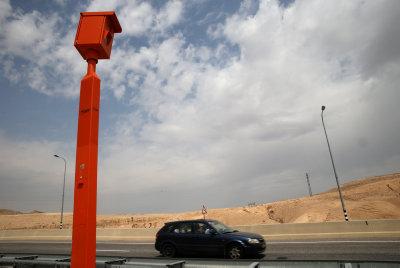Traffic Cameras to Catch Bus Lane Violaters

In lieu of an extensive train system, the public transportation option for many Israelis is the bus – which is subject to the same traffic jams that private cars are. The solution, of course, is to dedicate public transportation lanes to buses, but few highways in Israel have such lanes – and in addition, enforcement has been extremely lax, because of a lack of manpower among police for the kind of highway presence needed to enforce such a law.
Technology to the rescue. Police in recent months have set up dozens of cameras on main arteries – with the latest four set up this week on Road 2, the coastal road between Haifa and Tel Aviv. The cameras will keep an eye on bus lanes, and record the license plate numbers of violators, who could expect to receive a NIS 500 fine.
Police are waiting for final authorizations to turn on the cameras and begin using them. Part of the reason for the delay was a lawsuit that demanded police guarantee that the camera be used only to observe traffic in the public transportation lanes, and not use them for speed enforcement or enforcement of other traffic rules. With the final authorizations now pending, the cameras on Road 2 and the Ayalon Expressway in Tel Aviv are expected to go into service by the end of the year.
These cameras are just the beginning. In recent weeks, the Knesset Economic Committee authorized an initial plan to allow municipalities to set up cameras in 300 kilometers of public transportation lanes and allow them to collect fines from drivers who violate the rules. Here, too, fines for violators will be up to NIS 500. The plan is designed to ensure the smooth flow of public transportation, in the hope that if buses can move faster, more people will be encouraged to use them instead of their cars, the Committee said.
To Read The Full Story
Are you already a subscriber?
Click "Sign In" to log in!

Become a Web Subscriber
Click “Subscribe” below to begin the process of becoming a new subscriber.

Become a Print + Web Subscriber
Click “Subscribe” below to begin the process of becoming a new subscriber.

Renew Print + Web Subscription
Click “Renew Subscription” below to begin the process of renewing your subscription.












